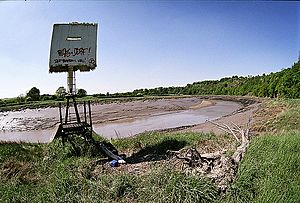Horseshoe Bend, Shirehampton facts for kids
|
||||||||||||||||
Horseshoe Bend, Shirehampton is a special natural area in Bristol, England. It's officially known as a "Site of Special Scientific Interest" (SSSI) because it has unique plants and features. This area is about 11 acres (4.45 hectares) big. You can find it on the north side of the River Avon, near the village of Shirehampton. It became an SSSI in 1999.
Contents
What Makes Horseshoe Bend Special?
Horseshoe Bend has two main parts: a wooded cliff and a narrow salt marsh. A salt marsh is a coastal wetland that gets flooded by salty water from the river or sea.
The Rocks Beneath Your Feet
The ground here is made of very old rocks. The deepest layers are Devonian sandstone and Carboniferous limestone. These rocks formed millions of years ago! On top of them, there's a layer of Triassic conglomerate. Conglomerate is a type of rock made from many different pebbles and stones cemented together. This particular conglomerate also contains a mineral called dolomite.
Amazing Plants and Trees
Horseshoe Bend is home to some very rare and interesting plants.
Trees on the Cliff
The main reason this area is an SSSI is because of a tree called the True Service-tree (Sorbus domestica). This tree is super rare in Britain, and Horseshoe Bend has the largest group of them in England!
Other special trees you might find here are two types of whitebeam trees: Sorbus eminens and Sorbus anglica. These are also very rare in Britain. Another uncommon tree is the Large-leaved Lime (Tilia platyphyllos).
You can also spot some interesting smaller plants like Field Garlic (Allium oleraceum) and Pale St. John's-wort (Hypericum montanum).
Plants in the Salt Marsh
The salt marsh area is mostly covered by plants like Sea Aster (Aster tripolium) and English Scurvygrass (Cochlearia anglica). These plants are tough and can handle the salty water.
There are also two other rare plants here: Slender Hare's-ear (Bupleurum tenuissimum) and Long-stalked Orache (Atriplex longipes). These are known as "vascular plants," which means they have special tissues to carry water and nutrients, just like most plants you know.
The Story of the Kron Prinz Shipwreck
On April 1, 1874, a German grain ship named the SS Kron Prinz was being pulled up the River Avon. It was carrying a huge amount of grain, about 7,000 quarters (which is like 1,000 cubic meters!).
Even though the tide was high and there was enough water, the ship got stuck on the outer bank of the narrow channel at Horseshoe Bend. As the tide went out, the ship leaned over onto the muddy bank and then completely fell onto its side!
All the grain cargo was lost. To make sure the ship didn't block the river for other boats, its masts were removed. Nearly three weeks later, on April 20, the ship was finally pulled free. It was taken to Bristol for repairs, which cost a lot of money – about £34,000 back then!
A famous photograph was taken of the Kron Prinz lying on its side from across the river. This picture was later made into a postcard by a local photographer named Fred Little. The ship was later renamed the SS Idraet and sadly sank in the North Sea in 1899.




